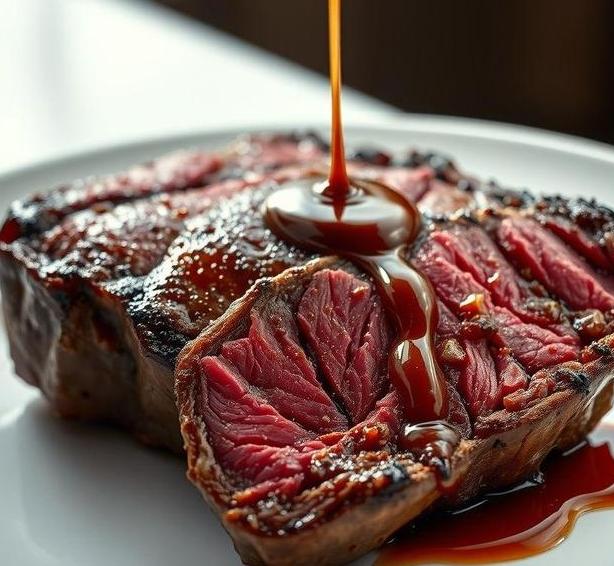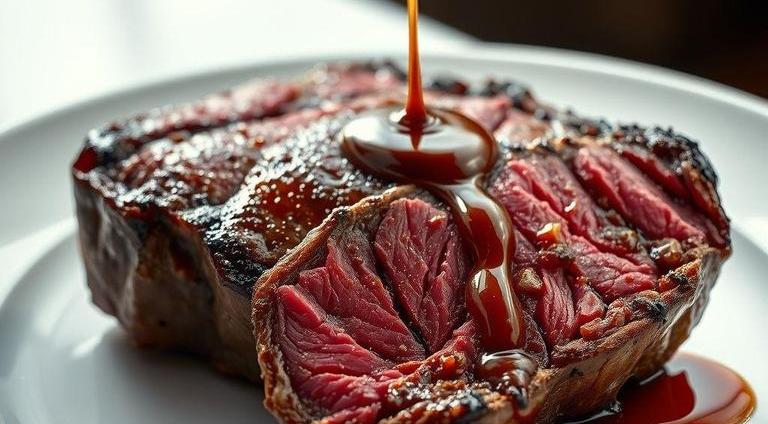- You are here:
- Home »
- Food Shelf Life
- » Can Beef Go Bad : What You MUST Know
Can Beef Go Bad : What You MUST Know
Beef, a cornerstone of many diets around the world, is loved for its rich flavor and versatility. Whether you’re grilling a steak, preparing a hearty stew, or making a juicy burger, it’s hard to go wrong with this protein-packed option. However, like all perishable foods, beef has a shelf life, and knowing how to handle it properly is essential to avoid foodborne illness and waste.
In this guide, we’ll break down everything you need to know about beef spoilage-from how to spot bad beef to tips on how to store it properly, so you can enjoy it at its best. If you’ve ever wondered how long beef lasts or what to do when you’re not sure if it’s still good to eat, keep reading!
Can Beef Go Bad?
Yes, beef can absolutely go bad. All meats, including beef, are prone to spoilage due to bacteria growth, oxidation, and natural enzymes that break down the meat over time. Even if the beef looks fine at first glance, it might have already started to degrade at a microscopic level. Spoiled beef not only loses its taste and texture but can also be dangerous to consume, leading to foodborne illnesses.
Several factors contribute to beef going bad:
- Bacterial Growth: Pathogens like Salmonella and E. coli are common culprits of foodborne illness, and they thrive in the right conditions, often in beef that is stored improperly.
- Oxidation: Oxygen exposure can cause beef to spoil by degrading its fats and proteins, leading to off flavors and unpleasant smells.
- Time: Even with proper storage, beef doesn’t last forever, and over time, it naturally breaks down, leading to spoilage.
Understanding the factors that cause beef to go bad can help you avoid these pitfalls and maximize the freshness of your meat.
Shelf Life For Beef

Beef’s shelf life varies depending on its cut, how it’s stored, and whether it’s fresh or cooked. Here’s a detailed breakdown of how long different types of beef last under various conditions:
Fresh Beef (Uncooked)
-
Refrigerated (at or below 40°F / 4°C):
- Ground beef: 1 to 2 days
- Steaks, roasts, and other whole cuts: 3 to 5 days
-
Frozen (at or below 0°F / -18°C):
- Ground beef: 3 to 4 months
- Steaks and roasts: 6 to 12 months
Cooked Beef
-
Refrigerated (at or below 40°F / 4°C):
- 3 to 4 days
-
Frozen (at or below 0°F / -18°C):
- 2 to 3 months
Beef Jerky
-
Unopened (at room temperature):
- 1 to 2 months
-
Opened
- 1 to 2 weeks (if refrigerated)
Canned Beef (like Corned Beef Or Other Preserved Forms)
-
Unopened
- 2 to 5 years (check expiration dates)
-
Opened
- 3 to 4 days (refrigerated)
The shelf life of beef, like other meat, is heavily influenced by how it’s handled, stored, and whether it’s been previously frozen or thawed. Always check the packaging for specific expiration dates and keep your refrigerator and freezer at the proper temperatures.
Common Signs Of Spoilage
Knowing how to recognize spoiled beef is crucial to prevent illness. Beef, especially when it’s nearing the end of its shelf life, can show signs of spoilage that might not be immediately obvious. Here’s what you need to watch out for:
- Off or Sour Smell: One of the most obvious signs that beef has gone bad is an unpleasant odor. Fresh beef should have a clean, metallic or slightly sweet smell. If it has a sour, ammonia-like, or rotten smell, it’s definitely spoiled and should not be eaten.
-
Discoloration: Fresh beef is bright red, but this can change over time.
- Darkening: It may turn brown or grey, especially around the edges. This doesn’t necessarily mean it’s spoiled, as oxygen can cause this change. However, if it’s accompanied by other signs, it’s best to discard it.
- Greenish or Yellowish Tint: This is a bad sign. Beef should never have a greenish tint, which indicates bacterial growth or spoilage.
- Slimy Texture: Fresh beef should be firm and moist but not slimy. If the surface feels sticky, slippery, or overly wet, this is an indication that bacteria are present and the meat is decomposing.
- Dry or Tough Texture: Over time, beef loses moisture, which can make it dry and tough. If you notice the beef has dried out or seems tough to the touch, it could be a sign that it’s past its prime.
- Mold: While mold on beef is rare (since it doesn’t grow well on meat), it can happen if the beef has been improperly stored. If you notice any green, white, or blue patches on the meat, it’s best to throw it out.
How To Store Beef?

Proper storage is crucial for maximizing the shelf life of beef and preventing spoilage. Here’s how to store beef to keep it fresh for as long as possible:
In The Refrigerator
- Temperature: Beef should be stored at or below 40°F (4°C) to slow bacterial growth.
- Packaging: If you’ve bought beef in bulk, repackaging it in plastic wrap, aluminum foil, or airtight containers can help prevent oxidation and contamination. Be sure to wrap the beef tightly to prevent exposure to air.
- Placement: Store beef on the lowest shelf in your fridge to avoid drips contaminating other foods. Make sure it’s on a tray or plate to catch any juices.
- Do Not Store in Original Packaging for Too Long: Meat from the butcher often comes in plastic or butcher paper, but it’s best to transfer it to more airtight containers or freezer bags if you plan to keep it for a few days.
In The Freezer
- Temperature: Beef should be stored at 0°F (-18°C) or lower. This freezes the meat and halts bacterial growth.
- Freezer-Specific Packaging: Use heavy-duty freezer bags or vacuum-seal the beef. If you don’t have a vacuum sealer, make sure to remove as much air as possible from the bag to prevent freezer burn.
- Labeling: Always label packages with the date of purchase or freezing. This helps you keep track of how long the beef has been stored.
Thawing Beef
- Always thaw beef in the refrigerator or use the cold water method (submerged in a sealed plastic bag) to prevent bacteria growth. Never thaw beef at room temperature, as it can promote the growth of harmful bacteria.
Expert Tips
- Don’t Overbuy: Even if you find a great deal on beef, only buy as much as you can reasonably use within the shelf life. Meat is a perishable product, and overstocking can lead to waste.
- Vacuum Sealing for Longer Storage: If you’re freezing beef, consider investing in a vacuum sealer. This helps preserve the texture and flavor for longer periods, as it eliminates air that leads to freezer burn.
- Use a Meat Thermometer: When cooking beef, a meat thermometer ensures that you reach the safe cooking temperatures. Ground beef should reach 160°F (71°C), while steaks and roasts should reach at least 145°F (63°C) for medium-rare.
- Buy Fresh, Not Pre-Marinated: Pre-marinated beef often has a shorter shelf life due to the extra moisture and spices added. Fresh beef lasts longer and gives you more flexibility in seasoning and cooking.
- When in Doubt, Throw It Out: It’s better to be safe than sorry. If you’re unsure whether your beef is still good, trust your senses. If it smells bad, feels slimy, or looks questionable, discard it.
FAQs
Can Beef Go Bad If Left Out At Room Temperature?
Yes, beef can go bad if left at room temperature for more than 2 hours. The USDA recommends refrigerating or freezing beef within that time frame to prevent the growth of harmful bacteria.
How Can You Tell If Beef Has Gone Bad?
Signs that beef has gone bad include a sour or unpleasant odor, a slimy texture, or discoloration (such as brown or greyish spots). If the beef feels sticky or tacky to the touch, it may also indicate spoilage.
How Long Does Beef Last In The Refrigerator?
Raw beef can typically last 3-5 days in the refrigerator, depending on its cut and freshness. Ground beef has a shorter shelf life and should be consumed within 1-2 days of purchase.
Can Cooked Beef Go Bad In The Fridge?
Yes, cooked beef can go bad in the fridge. It should be consumed within 3-4 days of refrigeration. After that, the risk of bacterial growth increases, and the beef should be discarded.
Can Beef Be Stored In The Freezer, And For How Long?
Beef can be safely stored in the freezer for 4-12 months, depending on the cut. Ground beef should be consumed within 3-4 months for optimal quality, while steaks or roasts can last up to 12 months.
Does Freezing Beef Prevent It From Going Bad?
Freezing beef can significantly slow down spoilage and bacterial growth, but it doesn’t completely prevent it. Over time, frozen beef may develop freezer burn or lose quality, affecting taste and texture.
Can Beef Go Bad Even If It’s Been Frozen?
Yes, beef can go bad even if it’s been frozen, especially if it has been stored improperly or for too long. Freezer burn can cause the beef to dry out and lose flavor, but it’s still safe to eat if properly cooked.
How Can I Extend The Shelf Life Of Beef?
To extend the shelf life of beef, ensure it is stored properly in an airtight container or freezer bag. Refrigerate or freeze beef immediately after purchase and avoid leaving it at room temperature for extended periods.
What Happens If I Eat Beef That Has Gone Bad?
Eating beef that has gone bad can lead to foodborne illness, including symptoms like stomach cramps, vomiting, diarrhea, and fever. If you suspect you’ve eaten spoiled beef, seek medical attention if symptoms persist.
Can I Eat Beef That Smells Bad But Looks Fine?
No, it’s not safe to eat beef that smells bad, even if it looks fine. An unpleasant odor is a strong indicator that the beef has spoiled and may contain harmful bacteria.
